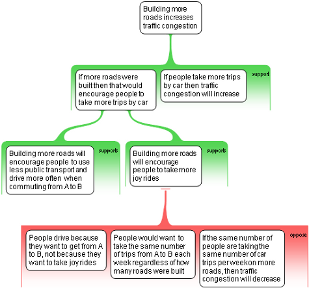
Image Credit:
Chris Ortiz y Prentice raises an interesting question in “Why we just can’t seem to teach logos.” As Chris says, analysis challenges both instructors and students as we struggle to understand the multi-faceted Greek term “logos.” Given rhetoric’s long and at times contentious relationship with formal logic, I agree that we should take a broader approach to the analysis of reasoning in persuasive texts. As for practical classroom activities, I think one answer, which bears some correspondence to the interactive fiction technology Chris discusses, is the use of argument mapping to describe and assess reasoning.
At the outset I want to distinguish mind mapping or concept mapping from the mapping of argumentation. Mind maps diagram a wide variety of information and ideas: from non-linear brainstorming to more hierarchal outlining to rhizomatic relationships. Argumentation mapping has a narrower focus. It attempts to translate text-based arguments into various argument schemata including, but not limited to, formal logic, as described by Tim van Gelder.
While mind mapping has found favorable use in the writing classroom, more focused argumentation mapping software has gone unnoticed in rhetoric and writing (even as it receives attention in the fields of argumentation theory, informal logic, computer science, and business communication). Given the Toulmin model diagrams that appear in our writing textbooks and the other schemata we use to conceptualize logos, I think argumentation mapping could serve the writing classroom well.
However, I can't simply point out a tool that instructors can neatly plunk down into their own classroom practice for two connected reasons. First, the software available is limited in function for writing instruction purposes. Second, these limitations result from contested understandings of logos.
Rhetoric and writing is rightly cautious about the application of formal logic in rhetorical arguments. We do not resolve our civic debates through appeals to universally agreed premises, because such premises do not exist. Any attempt to locate and work from such premises inevitably excludes perspectives that belong in public discussions, as the variations of lived experience are stripped away in favor of clear and distinct perceptions.
The process of reasoning, though, can be conceived in ways different than the construction of logically sound syllogisms. In The Rhetoric of Reason James Crosswhite says, “The capacity for reason lies not in an independent rational mind but at least partly in the deep competences people have to be members of social groups that disclose the world and interpret things in a shared way” (43).
These competencies have their own patterns that diagramming can capture. One productive and long-standing rhetorical schema is that of stasis theory. Stasis, as described in Sharon Crowley and Debra Hawhee's Ancient Rhetorics for Contemporary Students demonstrates how interlocutors do or do not converge on a common question to debate.
Stasis evokes spatial metaphors with its sense of a standpoint from which people pursue a line of reasoning. This visualization in turn lends itself to mapping where users can demonstrate the convergence or divergence of viewpoints. Unreasonable rhetors under the stasis theory model are not illogical; they are unreasonable because they do not engage the reasoning offered by their fellow discussants. Software that helps students create stasis maps could highlight not only breakdowns in communication but also directions in which discussants would need to move in order to regain stasis.
As I said above, no current software is especially well-suited to using such schemata. Philosophy Professor Maralee Harrell reviews several programs in "Using Argument Diagramming Software in the Classroom" [pdf copy], but finds that most are not adaptable enough for classroom use. Even in the context of philosophy courses where the study of formal logic has more relevance than it does in rhetoric, Harrell finds that most of the software currently available limited in terms of the flexibility of map organization or doesn't allow for on-the-fly classroom demonstration that can draw on student participation.
As most argument mapping programs employ schemata that are too close to formal logical syllogisms, one option is to adapt mind mapping software to provide more freedom in designing maps, but this comes with the trade-off of losing the guided template designs that help students construct maps that describe stasis, fair summary, and other elements of persuasive interaction. The interactive dimension is key, as argumentation is a participatory activity. Per Crosswhite's definition, we cannot assess the reasonableness of arguments in isolation but only in the way they work together to create community.
The underlying structure of mind maps presents central ideas with sub-units branching off and connecting. You can describe complex interrelationships in a mind map, but I'm not sure how well the mind map structure can capture the diachronic and interactive dimensions of argumentation that involves two or more interlocutors. Discussants exchange viewpoints over time, and each proffered argument shapes the others that later respond. Perhaps a map with animation, three dimensions and the capacity to zoom to different levels of detail as with Prezi could address these needs.
While such complexity might assist in crafting maps with a high level of fidelility to the argumentative landscape they represent, it isn't needed to assist students and instructors with more limited analyses of reasoning. More limited maps can evaluate whether sources are in stasis, whether they fairly represent the different positions at play, and can describe other aspects of the dialectical relationship between viewpoints in order to show the extent to which they abide by the competencies of reason.

